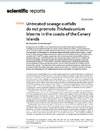Please use this identifier to cite or link to this item:
https://accedacris.ulpgc.es/jspui/handle/10553/75111
| DC Field | Value | Language |
|---|---|---|
| dc.contributor.author | Benavides Gorostegui,Mar | en_US |
| dc.contributor.author | Arístegui Ruiz, Javier | en_US |
| dc.date.accessioned | 2020-10-29T14:09:04Z | - |
| dc.date.available | 2020-10-29T14:09:04Z | - |
| dc.date.issued | 2020 | en_US |
| dc.identifier.issn | 2045-2322 | en_US |
| dc.identifier.other | Scopus | - |
| dc.identifier.uri | https://accedacris.ulpgc.es/handle/10553/75111 | - |
| dc.description.abstract | During the summer of 2017, recurrent extensive blooms of the diazotrophic cyanobacterium Trichodesmium invaded the beaches and coastal waters of the Canary Islands, causing great social alarm. Some local media and public sectors ascribed, without any strong scientifc evidence, the origin and reactivation of these blooms to untreated sewage outfalls distributed along the coasts. In order to test whether sewage outfalls could have any infuence on the metabolic activity of Trichodesmium, we performed 13C and 15N2 uptake experiments with colonies experiencing three diferent bloom development stages, incubated both with clear seawater and sewage water from an outfall south of Gran Canaria island. Our results showed that sewage outfalls did not promote any increase in dinitrogen (N2) fxation in Trichodesmium, supporting the hypothesis that decaying blooms were generated ofshore and transported shoreward by local currents and winds, accumulating mostly leeward of the islands. The combination of unusually warm seawater temperatures, enhanced and sustained stratifcation of the upper water column and recurrent dust deposition events would have favored the development of the Trichodesmium blooms, which lasted for at least four months. | en_US |
| dc.language | eng | en_US |
| dc.relation.ispartof | Scientific Reports | en_US |
| dc.source | Scientific Reports [EISSN 2045-2322], v. 10(1), 18386 (Diciembre 2020) | en_US |
| dc.subject | 251001 Oceanografía biológica | en_US |
| dc.title | Untreated sewage outfalls do not promote Trichodesmium blooms in the coasts of the Canary Islands | en_US |
| dc.type | info:eu-repo/semantics/article | en_US |
| dc.type | Article | en_US |
| dc.identifier.doi | 10.1038/s41598-020-75447-1 | en_US |
| dc.identifier.scopus | 85094173699 | - |
| dc.contributor.authorscopusid | 36501571300 | - |
| dc.contributor.authorscopusid | 7006816204 | - |
| dc.identifier.eissn | 2045-2322 | - |
| dc.identifier.issue | 1 | - |
| dc.relation.volume | 10 | en_US |
| dc.investigacion | Ciencias | - |
| dc.type2 | Artículo | en_US |
| dc.description.numberofpages | 8 | en_US |
| dc.utils.revision | Sí | - |
| dc.date.coverdate | Diciembre 2020 | en_US |
| dc.identifier.ulpgc | Sí | - |
| dc.contributor.buulpgc | BU-BAS | en_US |
| dc.description.sjr | 1,24 | |
| dc.description.jcr | 4,379 | |
| dc.description.sjrq | Q1 | |
| dc.description.jcrq | Q1 | |
| dc.description.scie | SCIE | |
| item.grantfulltext | open | - |
| item.fulltext | Con texto completo | - |
| crisitem.author.dept | GIR IOCAG: Oceanografía Biológica y Algología Aplicada | - |
| crisitem.author.dept | IU de Oceanografía y Cambio Global | - |
| crisitem.author.dept | Departamento de Biología | - |
| crisitem.author.orcid | 0000-0002-7526-7741 | - |
| crisitem.author.parentorg | IU de Oceanografía y Cambio Global | - |
| crisitem.author.fullName | Benavides Gorostegui,Mar | - |
| crisitem.author.fullName | Arístegui Ruiz, Javier | - |
| Appears in Collections: | Artículos | |
SCOPUSTM
Citations
7
checked on Jun 8, 2025
WEB OF SCIENCETM
Citations
7
checked on Jun 8, 2025
Page view(s)
173
checked on May 31, 2025
Download(s)
150
checked on May 31, 2025
Google ScholarTM
Check
Altmetric
Share
Export metadata
Items in accedaCRIS are protected by copyright, with all rights reserved, unless otherwise indicated.
